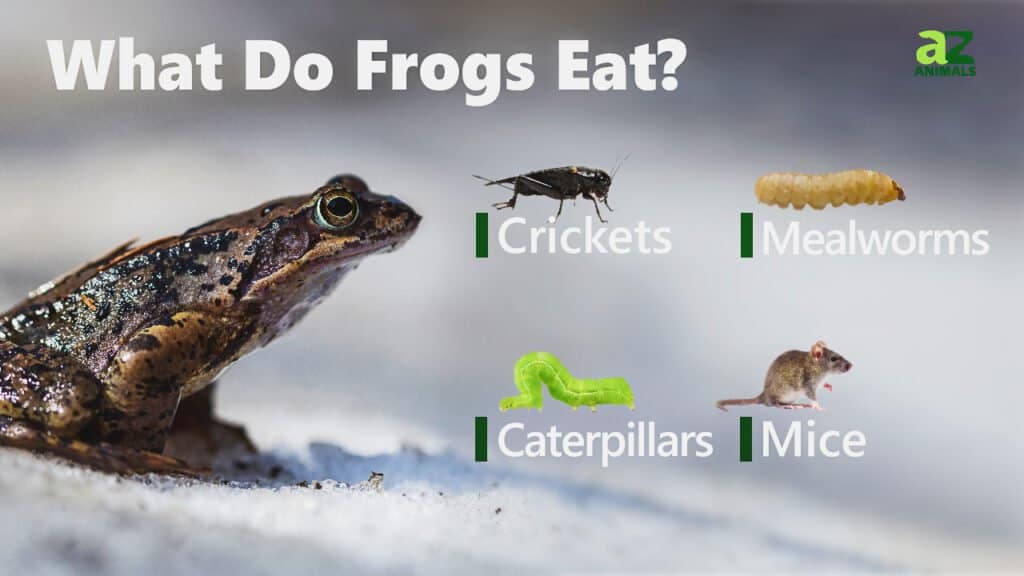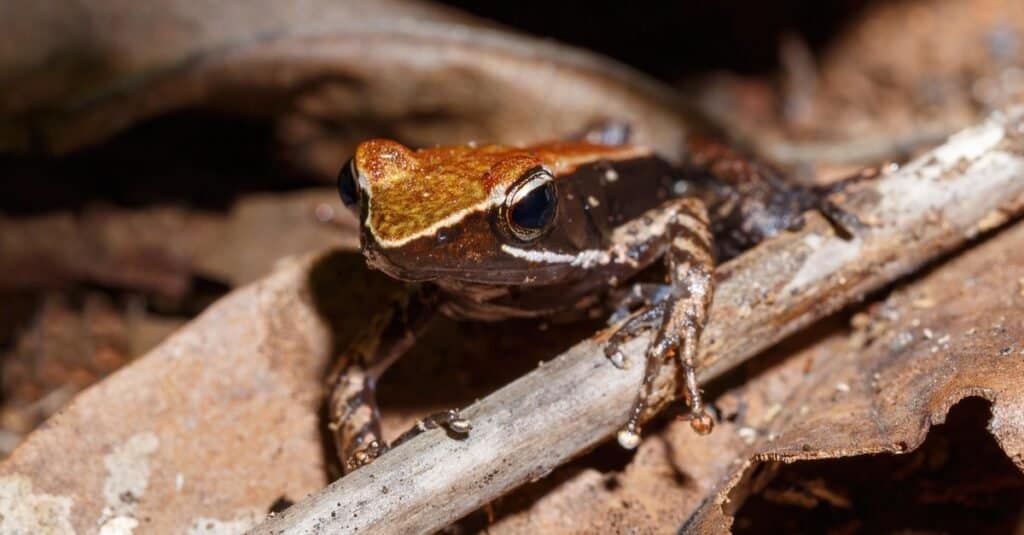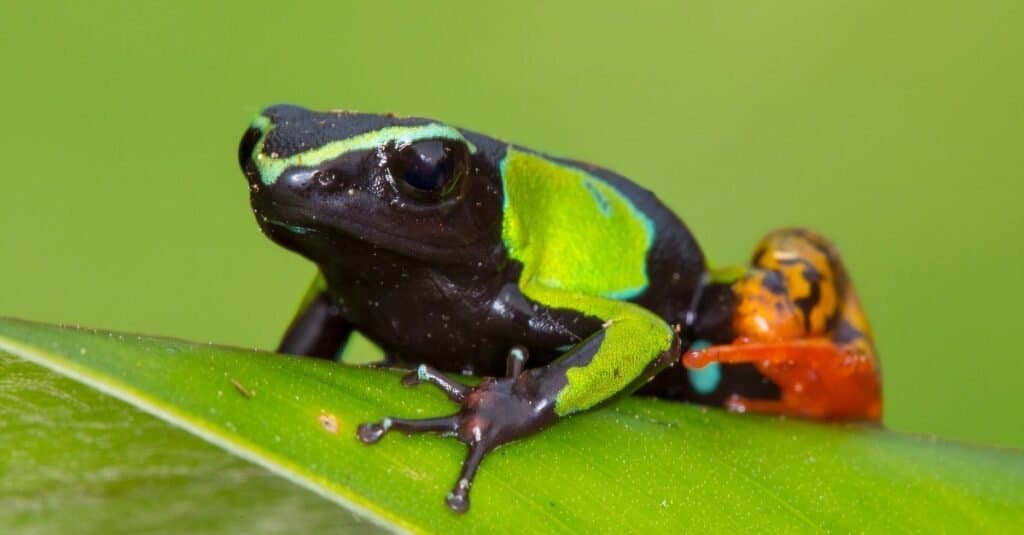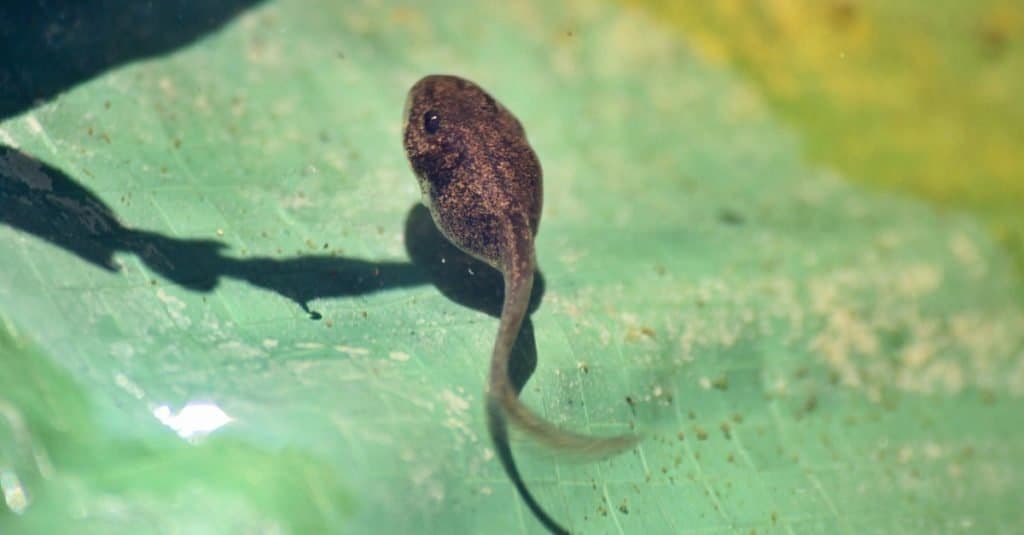Frogs are the most common amphibians on the planet, and it’s not even close. Of the nearly 8,000 known species of amphibians, nearly 7,000 of them classify as frogs. Frogs need moisture to live and tend to live in ponds, rivers, or lakes, as well as woodlands or grasslands. They range throughout every continent excluding Antarctica, with most species occurring in tropical climates. You’ve likely heard an army of frogs croaking at night, which is when most frogs get active. During the day, many frogs blend into their environment or rest under logs, rocks, or leaves. However, once the sun sets and the moon rises, frogs come out to hunt. You’ve likely seen videos or pictures of frogs sticky out their tongues in search of food. That said, few people know the answer to the question “what do frogs eat?”
To answer this question, we’ll examine what common foods most frogs like to eat. In addition, we’ll explore how frogs hunt and forage for food. We’ll also take a moment to compare what frogs eat in the wild versus what they eat as pets. Finally, we’ll end with a brief discussion of what baby frogs eat. Let’s hop along to the next section and get started exploring all there is to know about frogs and their diet.
What Do Frogs Like to Eat?

By and large, most frogs eat a carnivorous diet that primarily consists of locally available insects and mollusks. That said, frogs will eat other small prey when available, including small mammals, birds, reptiles, and even other frogs. On average, frogs prefer live prey to dead ones, and adult frogs almost never eat carrion. However, the same can’t be said for tadpoles, which will occasionally eat dead insects and animal matter. In addition, when tadpoles, frogs will go through an herbivorous phase where they eat mostly plants. Much like a person, the tastes of a frog change as it grows from an adolescent into an adult. All of this is to say that frogs eat a wide variety of foods based on their age, size, and environment. To simplify things, we’ve boiled the list down to 10 items that most frogs eat at some point. The list includes:
- Insects
- Mollusks
- Birds
- Rodents
- Fish
- Algae
- Spiders
- Reptiles
- Amphibians
- Aquatic plants
Within these categories, you can find foods that make up the diet of practically every known species of frog. While most frogs eat primarily insects, they aren’t true insectivores as they may also eat other forms of meat. In addition, since others go through a predominantly herbivorous tadpole stage, the term carnivore also doesn’t suffice. Therefore, it’s accurate to say that most frogs live as omnivores, eating both plants and meat, although rarely at the same time.
How Do Frogs Hunt and Forage For Food?

Frogs can shoot out their tongue and catch prey in less than .07 seconds.
©Artush/Shutterstock.com
Like other animals, frogs evolved a number of highly-developed senses to help them find food. First and foremost, frogs possess a keen sense of touch. Using the micro sensory organs beneath their skin, frogs can detect changes in temperature, pressure, and vibrations around them. Through these vibrations, they can identify the size and location of a particular prey. In addition, frogs also developed a sensitive sense of taste. As a result, frogs won’t eat certain foods that they find repellent. This likely explains why they avoid carrion, and generally only eat live prey. While frogs struggle to focus on objects up close, they possess great long-distance and night vision. In particular, frogs’ eyes are highly sensitive to movement, and their large peripheral vision helps them to spot prey. Frogs can also smell prey with their nostrils, as well as chemicals in the water around them.
Frogs use different hunting styles depending on their physiology and environment. That said, most frogs rely on their long, sticky tongues to catch prey. A frog can lift prey nearly 1.4 times its body weight with just its tongue. In addition, a frog can shoot out its tongue and snag prey in less than .07 seconds. This kind of speed makes frogs very effective at catching even agile, flying insects like flies and mosquitoes. Once a frog spots a target, it wraps its super flexible tongue around its prey and coats it with sticky saliva. Then, it will yank its tongue back with a force equal to twelve times greater than the force of gravity. Frogs swallow their prey whole, as they can’t chew. What little teeth they have serve only to hold prey in place rather than chew their food up.
What Do Frogs Eat in the Wild?

Frogs eat a wide variety of insects and mollusks.
©iStock.com/Massimo_S8
As previously mentioned, most frogs eat a carnivorous diet that consists primarily of insects and small animals. That said, some also go through a tadpole stage where they eat a mostly herbivorous diet. Suffice to say, frogs eat foods that they can find and catch in abundance in their local environment. At the same time, frogs can also be picky eaters, and will not eat foods that they find distasteful. Frogs as a whole tend to only eat live prey, and will rarely if ever eat carrion. Since frogs are ectotherms, they become less active in winter, and so only actively hunt for food when the weather is warm.
Common insects that frogs eat include fruit flies, dragonflies, beetles, crickets, grasshoppers, ants, and termites. In addition, frogs will also eat worms, slugs, snails, and spiders. Outside of insects and other critters, frogs will also eat animals smaller than them. This includes small birds, bats, mice, turtles, and lizards. Some frogs will also cannibalize members of their own species and eat other, smaller frogs and frog eggs. Furthermore, many frogs will also eat small fish such as minnows, guppies, and goldfish.
What Do Pet Frogs Eat?

Pet frogs prefer live prey but may also eat frog pellet food.
©Ken Griffiths/Shutterstock.com
What do frogs eat when they get to live a pampered life of domesticity? The truth is that each species of frog possess its own unique nutritional requirements. That said, pet frogs tend to eat the same foods as wild frogs. An adult pet frog will eat a variety of insects including crickets, flies, grasshoppers, and locusts. In addition, they’ll also to worms, redworms, bloodworms, mealworms, slugs, and snails. If you own a larger pet frog, you could also feed it live minnows or pinky mice. Just remember, most pet frogs only like to eat live prey. This means you’ll have to monitor your pet frog’s habitat periodically to make sure its food stays fresh. Finally, you can also supplement your frog’s live diet with frog pellet food.
Additionally, there are several foods that you should never feed to a pet frog. These include:
- Fruits
- Vegetables
- Leftovers
What Do Baby Frogs Eat?

Tadpoles primarily eat a diet of algae and aquatic plant matter.
©greggnormal/Shutterstock.com
What do frogs eat in their newly hatched tadpole form? Unlike adult frogs, tadpoles eat a largely plant-based diet along with the occasional insects. Shortly after birth, most tadpoles will eat any embryonic egg matter leftover from their egg and then start hunting for food. Tadpoles typically live off of algae growing on the bottom of leaves, rocks, or logs in ponds, streams, or lakes. However, they will also feed on aquatic plants like duckweed as well as soft mosses. Once they grow larger, tadpoles will begin to catch fruit flies, worms, and other small insects. Meanwhile, froglets, or frogs that don’t go through a tadpole phase, eat a similar diet. From birth, froglets will eat a diet composed of plants leaves and roots, water striders, and insect larvae.
Pet baby frogs will eat a similar diet to wild frogs, although some insects may be difficult to source. If you own a baby tadpole, you can feed them algae wafers, leaves, roots, and leafy green vegetables. You can also feed them frog and tadpole pellets, which contain many of the nutrients tadpoles need to grow. On the other hand, you should feed your pet froglet worms, crickets, fruit flies, moths, gnats, and mosquitoes. If appropriate, you can also feed small shrimp or crayfish to your froglet. Before doing so, make sure that any food is smaller than your frog to avoid any choking hazard. It’s advised that you check with your vet or pet store expert before adding new food to your baby frog’s diet.
The photo featured at the top of this post is © iStock.com/BrianLasenby
Thank you for reading! Have some feedback for us? Contact the AZ Animals editorial team.






